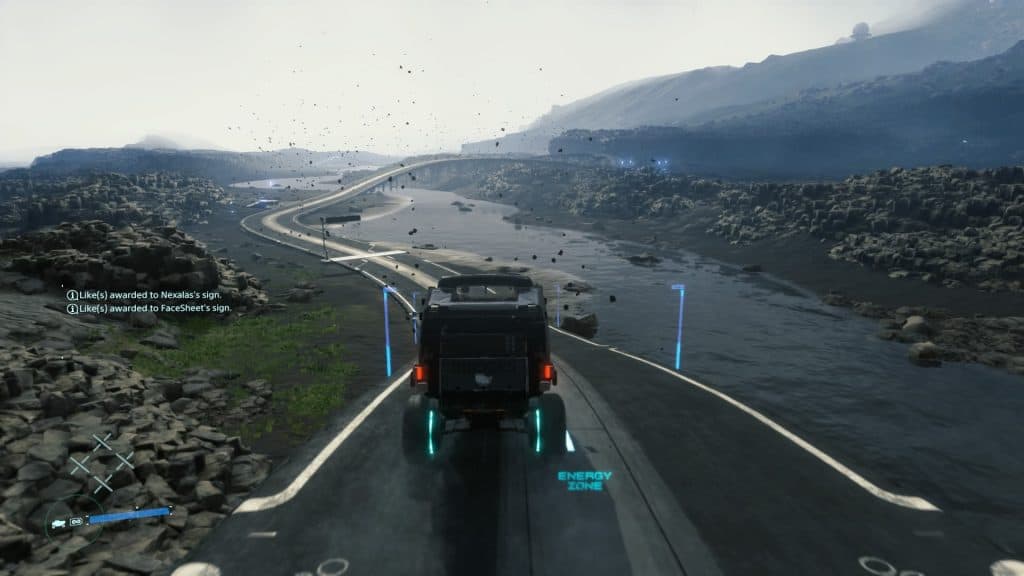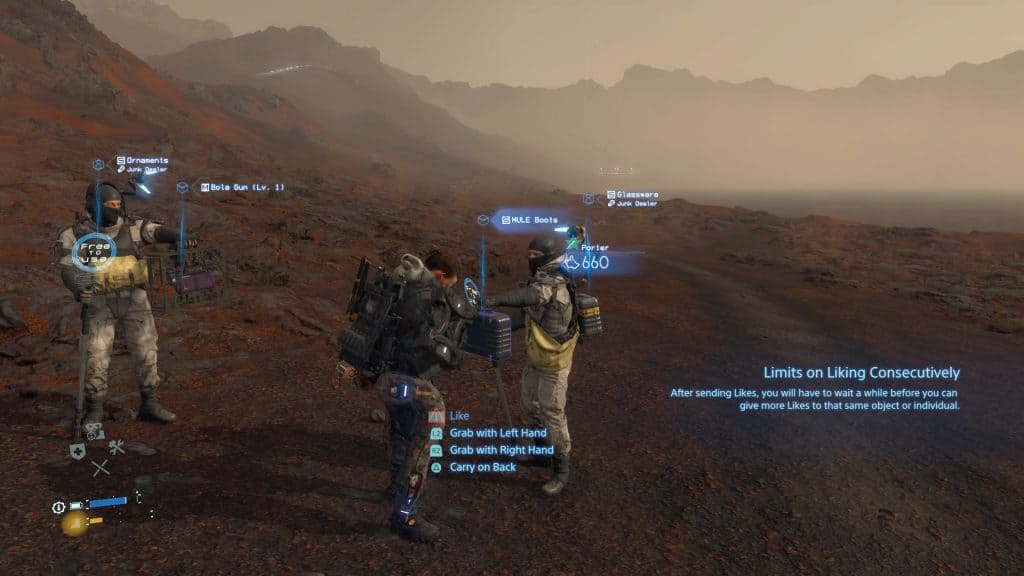A DeconRecon Special Feature
Death
Unstranding
Editor’s note: Hideo Kojima’s Death Stranding gives our writer some wheels and a life lesson. This is Entry Two of DeconRecon’s ‘Death Unstranding’ series. If you have not read Entry One, we strongly urge you to start from there — click here. Oh, and SPOILERS AHEAD.
Trikes, Likes, and Adrenaline Spikes
By: C Nge
Game chapters completed: 5
I take back everything I said about Death Stranding (DS) being a walking simulator.
In truth, it is a life simulator. And like most things in life, you have to suffer before you reap rewards; ‘no pain no gain’ as the saying goes, and Kojima sure knows how to hone this aphorism to perfection.
DS’ level design mirrors the stages of human development through startlingly simple game mechanics. As a baby, you would have had to crawl before you could walk, and walk before you could cycle or drive. Similarly, in DS you begin your game by walking and you do this for thousands of kilometers before Kojima decides to end your pedestrian suffering.
He does this by bestowing you with a reverse trike—a three-wheeled motorbike with two wheels in the front and one at the back. The moment I unlocked the trike, I instantly felt vindicated.

Feels on wheels
Don’t get me wrong — I love walking, but it was nice to have my dedication to the seemingly banal initial gameplay acknowledged, in the form of a vehicular gift. I could hear Kojima himself whispering in my ear: “You’ve walked long enough on your two feet to have earned your right to run with three wheels. Take a break now; go for a spin on me!”
So I did. Only there was one problem I did not anticipate: there were no roads. In some regions of the DS world there were partial roads but they never did reach my destinations.
I could build roads, sure, but I needed to haul tonnes of metal, ceramic, and resins, which I was reluctant to do. Huge stockpiles of aforesaid materials were also available in enemy MULE camps but being a peacenik, I did not deign to fight them for resources.
I figured I didn’t really need roads because trikes could tear up dirt paths, hill and mountain slopes, and even traverse rivers and creeks with remarkable ease and virtually no damage to their shells. But when I found myself in the middle of a sea of rocks or in front of a massive waterfall, what to do with my trike suddenly became a new problem I had no desire to fix.
Sure, I could just abandon my trike (as I did many times) and haul my cargo the rest of the way on my back, but because I knew I had a vehicle to begin with, I unthinkingly contracted to haul way more cargo than I could safely carry on foot. Thus, abandoning my trike would also mean abandoning part of my cargo.
The game has a feature that re-designates your carried cargo as “lost cargo” when you have moved sufficiently far enough away from it along your delivery route. Lost cargo can then be picked up by other porters to be delivered but you get no credit for them. Since DS is premised on your successful delivery of cargo, losing cargo is not a feather you would want to wear in your cap.
Additionally, being a sucky bike rider, I had the misfortune of doing things to my trike that no seasoned gamer would dream of attempting. I took my trike down gorges because I thought I could jump across them; I drove my trike into ravines because I mistook them for rocky outcrops; I thought it would be cool to see if my trike could get unstuck from a narrow crevasse and found out that the only thing that would come unstuck would be me, hurtling into a rocky abyss.

“Tell Hideo Kojima I love hiiiiiiiii—”
Contrary to what you might think, such incidents did NOT make me chortle or guffaw at my own ineptness. Instead I yelled, cursed, and raged over my many unsalvageable trikes—not to mention lament my lost cargo and failed deliveries. All the Zen accumulated (see Entry One) over two chapters of DS evaporated. I confess, it did not take me very long to go back to walking my deliveries because in the end, my reward turned out to be my worst enemy.
Until Kojima gave me a truck.
Do you want to know what’s worse than bouncing up and down, and up and down, AND up and down, on a trike through rocky terrain, then getting stuck between boulders every ten minutes while inching your way towards your destination? Not being able to bounce at all and getting absolutely nowhere because trucks cannot do wheelies over rocks.

There is a reason ‘truck’ and ‘stuck’ sound very alike
Yet we are all suckers for punishment for a reason: we think there must be a light at the end of the proverbial tunnel of pain. After all, this is the game designer who knows all about managing pain, phantom or otherwise.
And as Kojima wills it, there is consolation in this truckload of driving pain. The introduction of trucks into DS signalled a new imperative in the gameplay and what is conceivably the most satisfying game mechanic for me—something far more addictive than power walking: construction.
Having a truck compels you to build roads. Trucks enable you to complete gargantuan orders, totalling a few thousand kilograms of cargo just for one client in a single location. It just would not make sense to make countless trips on your trike over terrain you abhor—or walking the order, god forbid!—when you can easily hop into your truck and be done in minutes, only if you had roads.
Despite my love for all things ambulatory, I knew I had to eventually build roads if I had any hope of making real headway in DS without spending the whole of 2020 virtual-walking my way into gaming oblivion.
The game sets up road-building structures called auto-pavers, which literally (and magically) construct roads right in front of your eyes. All you need to do is to feed them with the requisite materials and once you have reached the established quota, voila! The road materialises and you suddenly feel the urge to channel your inner mat rempit or Mad Max.

My way AND the highway
The attraction of roads is that you are not alone in building them. Since DS is a networked game, other players can also contribute materials to make the road-building exercise less lonely. You might start off needing to load 4,320 units of ceramic into an auto-paver but after a few hours away from the game, you return to see that a fellow player has already contributed 2,160 units, lightening your load a little.
The attraction of roads is that you are not alone in building them. Share on XBuilding roads also gets you likes; the longer the highway, the faster you accumulate likes from other players. After countless hours feeding your auto-pavers, slowly building roads section by section across hundreds of kilometers, the joy of seeing the number of likes in your account rise from 500 to 5,000 then 50,000 and finally hitting 140,000 is, frankly, like getting a community service award.

Being Asian, of course I grabbed with both hands
The joy is not only found in building structures that will benefit you later on but also in the knowledge that your road is now going to help countless others as they explore and enjoy the same world you both inhabit together, albeit asynchronously.
Even though I considered road-building to be the pinnacle of human achievement in DS, nothing prepared me for Kojima’s pièce de résistance, which I unwittingly unlocked at the start of Chapter Five: zip lines!
Truth be told, I did not really know what they were before I built them. I knew they would enable me to travel at great speeds but I thought I could only build them in elevated areas since they operate on the basis of gravity. But these are zip lines in the Kojima-verse so the laws of gravity need not apply.
One taste of their zippiness — pure adrenaline rush that made me shriek in unadulterated elation — and I was hooked. Constructing zip lines became my mission in DS. I am not ashamed to say I forwent the story, the characters, the cargo, the deliveries — even the deadline for submitting this entry — just so I could build as many zip lines as it would take to connect all the clients on my cargo delivery list. I sunk more than 20 hours of gameplay into erecting them, upgrading them, customizing them, and dismantling the ones that were not built in optimal locations.

Sorry for the blurry selfie BUT YES THAT’S A BABY #ResponsibleNanny
Needless to say, I spent a ton of those hours zipping and tripping over myself laughing with glee; mocking at my enemies trying to chase me from below; and marvelling at how the DS‘ Decima game engine could render the scenery at such a high resolution when I was whizzing through the air at top speed.
Straight up, no game has thrilled me this much in my entire life.
In the end, DS did teach me a valuable life lesson: put in your share of hard work as you stick with all the ups and downs that the world throws at you, but don’t forget to enjoy life’s simple pleasures: like feeling the wind in your hair as you soar above your troubles.
____
End of Entry Two. Read Entry Three here.
Follow our Facebook, Twitter, or Instagram to stay updated with our latest posts
Share this? Go ahead, make someone’s day
Also published on Medium.